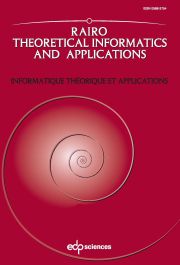Article contents
Abelian pattern avoidance in partial words∗
Published online by Cambridge University Press: 10 June 2014
Abstract
Pattern avoidance is an important topic in combinatorics on words which dates back to thebeginning of the twentieth century when Thue constructed an infinite word over a ternaryalphabet that avoids squares, i.e., a word with no two adjacent identicalfactors. This result finds applications in various algebraic contexts where more generalpatterns than squares are considered. On the other hand, Erdős raised the question as towhether there exists an infinite word that avoids abelian squares, i.e.,a word with no two adjacent factors being permutations of one another. Although thisquestion was answered affirmately years later, knowledge of abelian pattern avoidance israther limited. Recently, (abelian) pattern avoidance was initiated in the more generalframework of partial words, which allow for undefined positions called holes. In thispaper, we show that any pattern p with n> 3 distinct variables oflength at least 2n is abelian avoidable by a partial wordwith infinitely many holes, the bound on the length of p being tight. We completethe classification of all the binary and ternary patterns with respect to non-trivialabelian avoidability, in which no variable can be substituted by only one hole. We alsoinvestigate the abelian avoidability indices of the binary and ternary patterns.
Keywords
Information
- Type
- Research Article
- Information
- Copyright
- © EDP Sciences 2014
References
- 1
- Cited by

